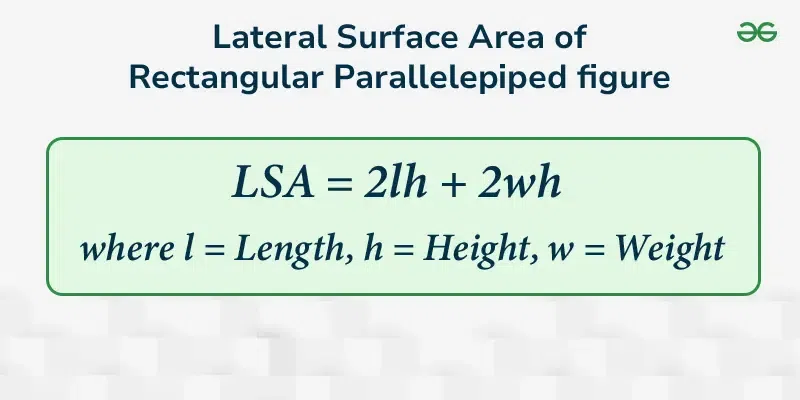
|
|
A Rectangular Parallelepiped is a polyhedron with six faces. Here each face is a rectangle. It can also be called a cuboid. It is a three dimensional (3D) figure. For any two dimensional or three-dimensional figures, the concept of mensuration is applied. Mensuration is the branch of geometry that deals with measurements like length, height, area, volume in 2D/3D figures. It includes the computation of mathematical formulas and algebraic expressions.  Rectangular Parallelepiped Formula Rectangular Parallelepiped Formula Surface Area of a Rectangular Parallelepiped figureIn the Rectangular Parallelepiped figure, there are six rectangles. To determine the surface area of it we need to find the area of six rectangles (faces). The formula for the surface area is given by  Surface Area of a Rectangular Parallelepiped figure
Lateral Surface Area of Rectangular Parallelepiped figureLateral Surface Area can be defined as the product of perimeter of base and height. In a rectangular parallelepiped figure, each face is a rectangle so the perimeter of the base is equal to the perimeter of rectangle. The formula for LSA (Lateral surface area) is given by  Lateral Surface Area of Rectangular Parallelepiped figure
From the above formula, It can also be said that
Also Check:
Volume of Rectangular Parallelepiped figureThe volume of rectangular parallelepiped can be defined as the product of the area of the base and height. As each face in a rectangular parallelepiped is rectangle, the base is also a rectangle and the area of base is the product of length and width. The formula for volume is given by-
Diagonal length of Rectangular Parallelepiped figureThe length of diagonal of rectangular parallelepiped figure with length l, width w and height h can be calculated by the below formula-
Let’s look into couple of questions based on Rectangular Parallelepiped Figure: Sample QuestionsQuestion 1: What is the surface area of Rectangular Parallelepiped with length 6cm, width 3cm and height 2cm. Solution:
Question 2: Find the surface area of the Rectangular Parallelepiped figure with length, width and height is 7cm, 5cm, 3cm respectively. Solution:
Question 3: What is the lateral surface area of Rectangular Parallelepiped with length 6cm, width 3cm and height 2cm. Solution:
Question 4: What is the volume of rectangular parallelepiped figures if the measurements such as length, width and height are 4cm, 3cm, 2cm respectively. Solution:
Question 5: Find the volume of rectangular parallelepiped figure if the length is 5cm, width is 4cm and height is 4cm. Solution:
Question 6: Find the volume of rectangular parallelepiped figure if the length is 5cm, width is 4cm and height is 2cm. Solution:
Question 7: Find the volume of rectangular parallelepiped figures if the length, width and height are 4cm, 2cm and 0.5cm respectively. Solution:
Practice Problems – Rectangular Parallelepiped Formula1. Find the surface area of a Rectangular Parallelepiped with length 8cm, width 5cm, and height 4cm. 2. Determine the lateral surface area of a Rectangular Parallelepiped with length 7cm, width 3cm, and height 6cm. 3. Calculate the volume of a Rectangular Parallelepiped with dimensions length 10cm, width 2cm, and height 5cm. 4. What is the diagonal length of a Rectangular Parallelepiped with length 6cm, width 2cm, and height 3cm? 5. Find the surface area of a Rectangular Parallelepiped with length 9cm, width 4cm, and height 7cm. 6. Determine the volume of a Rectangular Parallelepiped with length 5cm, width 5cm, and height 5cm. 7. Calculate the lateral surface area of a Rectangular Parallelepiped with length 3cm, width 2cm, and height 8cm. 8. What is the volume of a Rectangular Parallelepiped with length 12cm, width 3cm, and height 2cm? 9. Find the surface area of a Rectangular Parallelepiped with length 6cm, width 6cm, and height 6cm. 10. Determine the diagonal length of a Rectangular Parallelepiped with length 8cm, width 4cm, and height 3cm. ConclusionTo solve many problems in geometry it is important to be able to describe properties of a Rectangular Parallelepiped (or Cuboid) and perform associated calculations. The measure of the surface area, lateral surface area, volume and the length of a diagonal are basic geometrical properties which can be calculated by the help of definite formulas. Able to be applied on practical problems, these calculations are useful in architecture, engineering, and also many physical sciences. The required skills can be attained through solving various problems and using the given formulas in order to successfully mensuration three-dimensional figures. FAQs on Rectangular Parallelepiped FormulaWhat is a Rectangular Parallelepiped?
How do you calculate the surface area of a Rectangular Parallelepiped?
What is the formula for the volume of a Rectangular Parallelepiped?
How is the diagonal length of a Rectangular Parallelepiped determined?
What is the Lateral Surface Area of a Rectangular Parallelepiped?
How many edges does a Rectangular Parallelepiped have?
What is the difference between a Rectangular Parallelepiped and a Cube?
Is a Rectangular Parallelepiped the same as a Cuboid?
Can the length, width, and height of a Rectangular Parallelepiped be equal?
|
Reffered: https://www.geeksforgeeks.org
| Mathematics |
Type: | Geek |
Category: | Coding |
Sub Category: | Tutorial |
Uploaded by: | Admin |
Views: | 11 |